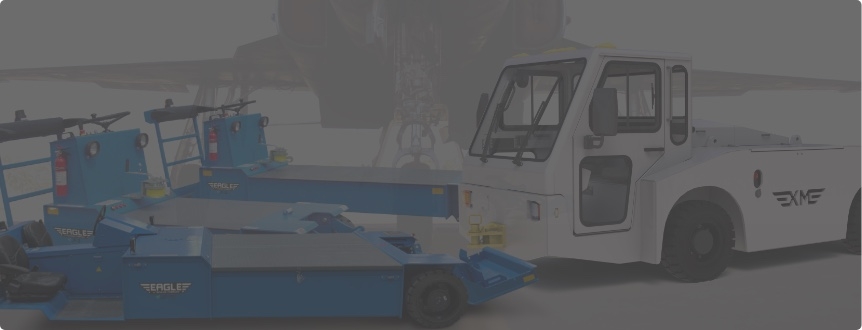While you should always have input from an expert before you purchase an aircraft tug, you may feel more comfortable with their recommendation if you understand the reasons behind it. Here, we'll let you in on some of the ways our experts make their recommendations when it’s time to guide you to the best new aircraft tugs for you.
Narrowing Down Options
The easiest way to begin to narrow down your options is by providing Eagle Tugs with some basic information and variables.
Look Up Your Aircraft’s Rating And Weight Range
When determining the type of airplane tug or towbarless tug to purchase, the first step is knowing the maximum takeoff weight (MTOW) of your largest aircraft.
Note Your Location
Your location is vitally important. This information tells us the general weather conditions the aircraft tug will be subject to. Why is this important? Adverse conditions impact performance. Operating conditions and location make such a big difference, in fact, that they often times are determining factors in finding the perfect solution for a customer.
Know Your Application Grade
Having the grade (percent of slope) for the application and surface conditions tells us if you'll need an aircraft tug larger than normally required to handle large inclines. Performance of the vehicle can be affected by steep slopes, especially when stopping.
Verifying A Match
Our experts are so familiar with the effects of the above variables that, from MTOW and location alone, they can start to home in on your best options with impressive accuracy. From there, two critical checks are used to verify that you’re getting the correct aircraft tug.
Drawbar Pull Calculations
Moving any aircraft requires a certain amount of drawbar pull (DBP), which is measured in terms of pound-force (lbf.) The confusing part is that the amount of DBP needed to pull the same aircraft will vary based on circumstances. Likewise, the amount of DBP delivered by an aircraft tug will also vary based on operating conditions.
To verify that a particular aircraft tug will indeed provide enough power for a particular customer's application, Eagle Tugs uses data about the customer's intended application to calculate and compare two numbers:
-
Just how much DBP will be needed in the customer's specific application
-
How much DBP a given aircraft tug will deliver in the customer's specified conditions
The calculations look like this:
Tractive Effort Required = (Wa + Wt) x (Gr + Br + Rr)
Drawbar Pull Delivered = Wd x COF
Wa = maximum takeoff weight of the aircraft (in lbs.)
Wt = weight of the aircraft tug (in lbs.)
Gr = steepest slope or "grade" the aircraft tug will have to traverse (a percentage, treated as a decimal)
Br = breakaway coefficient (assumed 4.0% based on SAE AIR 1363 standards, treated as .040)
Rr = rolling resistance (a percentage, treated as a decimal)
Wd = total weight on drive axle(s) of aircraft tug
COF = coefficient of friction (the amount of tractive effort transferred to the ground, which varies by weather conditions)
The COF used in the calculation should be based on the worst conditions an aircraft tug will encounter because it can vary significantly. For example, the COF will be .9 on dry brushed concrete. However, it will be .66 on standard wet concrete and as low as .5 on snow or ice, even with chains on the aircraft tug tires.
While the exact numbers will vary in each scenario, the drawbar pull delivered must always be higher than the drawbar pull required for an aircraft tug to be recommended in a given application.
The Aviation Customer Requirements (ACR) Form
It’s also extremely important to fill out the Aviation Customer Requirements (ACR) form, which an Eagle Tugs representative can provide to you. This questionnaire helps Eagle Tugs fully understand your needs as well as any additional requirements you may have, allowing us to better determine the right aircraft tug for you.
Find The Right Aircraft Tug
Choosing an airline tug is not something you should do on your own. Let us help. Ask the experts about the airplane tugs available through Eagle Tugs and request a quote and your ACR form today.
Related Articles
 IMPORTANT CONSIDERATIONS TO KEEP IN MIND WHEN CHOOSING MILITARY AIRCRAFT GROUND SUPPORT EQUIPMENT Like commercial airports worldwide, government airports require military aircraft ground support equipment (GSE) to help their daily operations run smoothly. With the importance of successful...
IMPORTANT CONSIDERATIONS TO KEEP IN MIND WHEN CHOOSING MILITARY AIRCRAFT GROUND SUPPORT EQUIPMENT Like commercial airports worldwide, government airports require military aircraft ground support equipment (GSE) to help their daily operations run smoothly. With the importance of successful... HOW TO CHOOSE THE RIGHT AIRCRAFT TUG FOR YOUR OPERATIONS Whether you own a personal aircraft or are in charge of an entire fleet, it can get confusing trying to determine the proper aircraft tug for your specialized operations...
HOW TO CHOOSE THE RIGHT AIRCRAFT TUG FOR YOUR OPERATIONS Whether you own a personal aircraft or are in charge of an entire fleet, it can get confusing trying to determine the proper aircraft tug for your specialized operations... DISCOVER THE UNMATCHED VERSATILITY OF TOWBARLESS AIRPLANE TUGS When transporting aircraft, you need ground support equipment (GSE) that is both efficient and safe. The compact and maneuverable towbarless airplane tug is the cost-effective solution you've been looking for...
DISCOVER THE UNMATCHED VERSATILITY OF TOWBARLESS AIRPLANE TUGS When transporting aircraft, you need ground support equipment (GSE) that is both efficient and safe. The compact and maneuverable towbarless airplane tug is the cost-effective solution you've been looking for...


